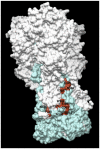A non-VH1-69 heterosubtypic neutralizing human monoclonal antibody protects mice against H1N1 and H5N1 viruses
- PMID: 22496802
- PMCID: PMC3319592
- DOI: 10.1371/journal.pone.0034415
A non-VH1-69 heterosubtypic neutralizing human monoclonal antibody protects mice against H1N1 and H5N1 viruses
Abstract
Influenza viruses are among the most important human pathogens and are responsible for annual epidemics and sporadic, potentially devastating pandemics. The humoral immune response plays an important role in the defense against these viruses, providing protection mainly by producing antibodies directed against the hemagglutinin (HA) glycoprotein. However, their high genetic variability allows the virus to evade the host immune response and the potential protection offered by seasonal vaccines. The emergence of resistance to antiviral drugs in recent years further limits the options available for the control of influenza. The development of alternative strategies for influenza prophylaxis and therapy is therefore urgently needed. In this study, we describe a human monoclonal antibody (PN-SIA49) that recognizes a highly conserved epitope located on the stem region of the HA and able to neutralize a broad spectrum of influenza viruses belonging to different subtypes (H1, H2 and H5). Furthermore, we describe its protective activity in mice after lethal challenge with H1N1 and H5N1 viruses suggesting a potential application in the treatment of influenza virus infections.
Conflict of interest statement
Figures




Similar articles
-
Unmasking Stem-Specific Neutralizing Epitopes by Abolishing N-Linked Glycosylation Sites of Influenza Virus Hemagglutinin Proteins for Vaccine Design.J Virol. 2016 Sep 12;90(19):8496-508. doi: 10.1128/JVI.00880-16. Print 2016 Oct 1. J Virol. 2016. PMID: 27440889 Free PMC article.
-
Heterosubtypic neutralizing monoclonal antibodies cross-protective against H5N1 and H1N1 recovered from human IgM+ memory B cells.PLoS One. 2008;3(12):e3942. doi: 10.1371/journal.pone.0003942. Epub 2008 Dec 16. PLoS One. 2008. PMID: 19079604 Free PMC article.
-
Potential Role of Nonneutralizing IgA Antibodies in Cross-Protective Immunity against Influenza A Viruses of Multiple Hemagglutinin Subtypes.J Virol. 2020 Jun 1;94(12):e00408-20. doi: 10.1128/JVI.00408-20. Print 2020 Jun 1. J Virol. 2020. PMID: 32269119 Free PMC article.
-
One step closer to universal influenza epitopes.Expert Rev Anti Infect Ther. 2009 Aug;7(6):687-90. doi: 10.1586/eri.09.48. Expert Rev Anti Infect Ther. 2009. PMID: 19681695 Review.
-
Influenza virus glycoprotein-reactive human monoclonal antibodies.Microbes Infect. 2020 Jul-Aug;22(6-7):263-271. doi: 10.1016/j.micinf.2020.06.003. Epub 2020 Jun 19. Microbes Infect. 2020. PMID: 32569735 Free PMC article. Review.
Cited by
-
Influenza virus antigenicity and broadly neutralizing epitopes.Curr Opin Virol. 2015 Apr;11:113-21. doi: 10.1016/j.coviro.2015.03.006. Epub 2015 Apr 4. Curr Opin Virol. 2015. PMID: 25846699 Free PMC article. Review.
-
Alternative recognition of the conserved stem epitope in influenza A virus hemagglutinin by a VH3-30-encoded heterosubtypic antibody.J Virol. 2014 Jun;88(12):7083-92. doi: 10.1128/JVI.00178-14. Epub 2014 Apr 9. J Virol. 2014. PMID: 24719426 Free PMC article.
-
Polyreactive Broadly Neutralizing B cells Are Selected to Provide Defense against Pandemic Threat Influenza Viruses.Immunity. 2020 Dec 15;53(6):1230-1244.e5. doi: 10.1016/j.immuni.2020.10.005. Epub 2020 Oct 22. Immunity. 2020. PMID: 33096040 Free PMC article.
-
A common solution to group 2 influenza virus neutralization.Proc Natl Acad Sci U S A. 2014 Jan 7;111(1):445-50. doi: 10.1073/pnas.1319058110. Epub 2013 Dec 11. Proc Natl Acad Sci U S A. 2014. PMID: 24335589 Free PMC article.
-
JC polyomavirus (JCV) and monoclonal antibodies: friends or potential foes?Clin Dev Immunol. 2013;2013:967581. doi: 10.1155/2013/967581. Epub 2013 Jun 25. Clin Dev Immunol. 2013. PMID: 23878587 Free PMC article. Review.
References
-
- Thompson WW, Shay DK, Weintraub E, Brammer L, Bridges CB, et al. Influenza-associated hospitalizations in the United States. Jama. 2004;292:1333–1340. - PubMed
-
- Fiore AE, Shay DK, Broder K, Iskander JK, Uyeki TM, et al. Prevention and control of influenza: recommendations of the Advisory Committee on Immunization Practices (ACIP), 2008. MMWR Recomm Rep. 2008;57:1–60. - PubMed
-
- Palese P. Influenza: old and new threats. Nat Med. 2004;10:S82–87. - PubMed
-
- Trifonov V, Khiabanian H, Rabadan R. Geographic dependence, surveillance, and origins of the 2009 influenza A (H1N1) virus. N Engl J Med. 2009;361:115–119. - PubMed
Publication types
MeSH terms
Substances
LinkOut - more resources
Full Text Sources
Other Literature Sources
Medical
Research Materials
Miscellaneous

